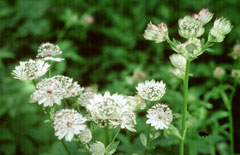 |
|
http://www.flickr.com/people/simonjoan/ |
 |
| http://commons.wikimedia.org/wiki/File:Astrantia_major_Sturm4.jpg |
Translate this page:
Summary
Bloom Color: Red.
Main Bloom Time: Early summer, Late spring. Form: Upright or erect.
Physical Characteristics

 Astrantia major is a PERENNIAL growing to 0.8 m (2ft 7in) by 0.5 m (1ft 8in) at a fast rate.
Astrantia major is a PERENNIAL growing to 0.8 m (2ft 7in) by 0.5 m (1ft 8in) at a fast rate.
See above for USDA hardiness. It is hardy to UK zone 6. It is in flower from May to July, and the seeds ripen from August to September. The species is hermaphrodite (has both male and female organs) and is pollinated by Beetles, insects. The plant is self-fertile.
Suitable for: light (sandy), medium (loamy) and heavy (clay) soils. Suitable pH: mildly acid, neutral and basic (mildly alkaline) soils. It can grow in semi-shade (light woodland) or no shade. It prefers moist soil.
UK Hardiness Map
US Hardiness Map
Synonyms
A. biebersteinii. A. carinthiaca. A. carniolica. non Wulf. A. trifida.
Plant Habitats
Woodland Garden Dappled Shade; Shady Edge;
Edible Uses
References More on Edible Uses
Medicinal Uses
Plants For A Future can not take any responsibility for any adverse effects from the use of plants. Always seek advice from a professional before using a plant medicinally.
Diuretic Purgative
A decoction of the root is purgative[7]. The root is harvested in summer to early autumn and can be dried for later use[7]. An infusion of the whole plant is a gentle diuretic[7].
References More on Medicinal Uses
The Bookshop: Edible Plant Books
Our Latest books on Perennial Plants For Food Forests and Permaculture Gardens in paperback or digital formats.

Edible Tropical Plants
Food Forest Plants for Hotter Conditions: 250+ Plants For Tropical Food Forests & Permaculture Gardens.
More

Edible Temperate Plants
Plants for Your Food Forest: 500 Plants for Temperate Food Forests & Permaculture Gardens.
More

More Books
PFAF have eight books available in paperback and digital formats. Browse the shop for more information.
Shop Now
Other Uses
References More on Other Uses
Cultivation details
Landscape Uses:Alpine garden, Border, Massing, Seashore, Woodland garden. Prefers a fertile moisture-retentive soil[200]. Succeeds in most well-drained soils[233] in full sun or part shade[200, 233]. Succeeds in an open woodland and along the sides of streams so long as the soil is well above the water level[200]. Plants are hardy to at least -17°c[200]. Plants spread by means of underground runners[233]. There are some named varieties, selected for their ornamental value[200]. The flowers are sometimes dried and used for winter decoration[200]. Special Features:Attractive foliage, Suitable for cut flowers, Suitable for dried flowers, Attractive flowers or blooms.
References Carbon Farming Information and Carbon Sequestration Information
Temperature Converter
Type a value in the Celsius field to convert the value to Fahrenheit:
Fahrenheit:
The PFAF Bookshop
Plants For A Future have a number of books available in paperback and digital form. Book titles include Edible Plants, Edible Perennials, Edible Trees,Edible Shrubs, Woodland Gardening, and Temperate Food Forest Plants. Our new book is Food Forest Plants For Hotter Conditions (Tropical and Sub-Tropical).
Shop Now
Plant Propagation
Seed - best sown in a cold frame as soon as it is ripe[200]. Sow stored seed as early in the year as you can obtain it. When large enough to handle, prick the seedlings out into individual pots and plant them out in the summer. If you have sufficient seed then it can be sown in situ either as soon as it is ripe or in the following spring. Division in spring. Large clumps can be planted out straight into their permanent positions. Smaller clumps are best potted up and kept in a cold frame until they are growing away well and can then be planted out in the summer.
Other Names
If available other names are mentioned here
Native Range
TEMPERATE ASIA: Azerbaijan EUROPE: Austria, Switzerland, Czech Republic, Germany, Hungary, Poland, Slovakia, Belarus (southwest), Lithuania, Latvia, Moldova, Ukraine (west), Albania, Bulgaria, Bosnia and Herzegovina, Croatia, Italy, North Macedonia, Montenegro, Romania, Serbia, Slovenia, Spain, France
Weed Potential
Right plant wrong place. We are currently updating this section.
Please note that a plant may be invasive in one area but may not in your area so it's worth checking.
Conservation Status
IUCN Red List of Threatened Plants Status :

Growth: S = slow M = medium F = fast. Soil: L = light (sandy) M = medium H = heavy (clay). pH: A = acid N = neutral B = basic (alkaline). Shade: F = full shade S = semi-shade N = no shade. Moisture: D = dry M = Moist We = wet Wa = water.
Now available:
Food Forest Plants for Mediterranean Conditions
350+ Perennial Plants For Mediterranean and Drier Food Forests and Permaculture Gardens.
[Paperback and eBook]
This is the third in Plants For A Future's series of plant guides for food forests tailored to
specific climate zones. Following volumes on temperate and tropical ecosystems, this book focuses
on species suited to Mediterranean conditions—regions with hot, dry summers and cool, wet winters,
often facing the added challenge of climate change.
Read More
Expert comment
Author
L.
Botanical References
17200
Links / References
For a list of references used on this page please go here
Readers comment
© 2010, Plants For A Future. Plants For A Future is a charitable company limited by guarantee, registered in England and Wales. Charity No. 1057719, Company No. 3204567.